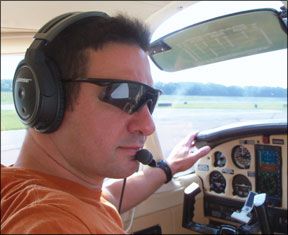Reviewing sunglasses is like reviewing clothing: Its grossly subjective and one size never fits all. But there are some important qualities to look for when choosing sunglasses for the cockpit. Special-purpose sunglasses arent cheap but the price tag isn’t a reliable predictor for performance. While sunglasses are an important part of pilot ego, we think theyre also a critical tool. In addition to protection from both visibly blinding and damaging UV sunlight, they should reduce eye fatigue, aid the eyes in transitioning from daylight to darkness and add clarity for effectively spotting traffic. They must also be comfortable under headsets for hours at a time and work we’ll with modern cockpit glass displays. And they have to look good. Here are our finds on what retailers know are top sellers and some of the up-and-coming brands trying to find a niche in the market. Obviously, we couldnt cover every model, so if a certain pair works we’ll for you in the cockpit, let us know.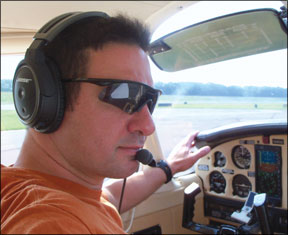
Youre So Vain
Call us narcissists (after all, we are pilots just like you) but style was high on our list of criteria and its where the testing got difficult. Style is subjective and one personality might like an athletic wrap-style frame while another might dig a square frame.
A smaller face is going to look like a beetle while wearing a huge pair of classic Ray Ban aviators. And, the temple frame design on some models isn’t going to fit every nose comfortably. Ray Ban, Oakley and Randolph Engineering offer their models in different sizes, just like shoes. Most of the so-called off-brands are one-size fits all.
As the comparison chart shows, comfort is a major category in which we judged, which includes wearing headsets and ball caps. The ability to easily remove and reinstall the glasses from the clamping of headphone ear cups is important. As a rule, glasses with grippy rubber earpieces will be a challenge. We also have yet to find a pair thats terrific while flying up in the teens with an oxygen cannula piped into our honker.
Names You Know
The brands most familiar in our test samples were Oakley, Ray Ban and Serengeti. Despite a table stacked with more sunglasses than we knew what to do with, we were drawn to familiar name brands first.
Originally founded by Bausch and Lomb, Ray Ban is the most recognizable name in glasses with an earned reputation for quality. The signature Ray Ban look is the green or brown G-15 series lenses in the familiar black wire frame. Polarized lenses are a poor choice for aircraft, but the model 3393s with non-polarized brown lenses performed we’ll in the glass-endowed, four-screen cockpit of a new Pilatus. The color did a good job of enhancing cloud definition while still reducing overall light and glare. The Pilatus driver told us they arent too dark as to make the transition back to all those cockpit screens and map/menu viewing any problem at all.
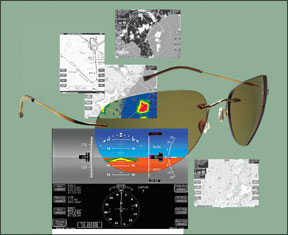
The shape is a bit of a wrap-around to keep outside glare in check. Comfort is good, although the temples do hook around the ear at about 30 degrees but are still comfortably wearable on usual 1000-mile, Bose-wearing hauls in the PC-12NG. They also proved to be reasonably good outside the aircraft while riding dirt bikes in the woods given their shatterproof build.
There were two pairs of Oakleys in our test group, the Oakley M-Frame Hybrid S wraps and the more traditional Tightrope model with polished black frame and black Iridium lens. The M-Frame was a recommendation of and top choice for several of our U.S. Marine contacts flying missions in the Middle East. Theyre also a top choice for athletes and available in interchangeable lenses and prescription.
The M-Frames offer full coverage with full-wrap, smoked HD Optics shatterproof lenses that perform flawlessly in most all lighting conditions. Weve worn them in the dark of night (don’t ask why) and were able to navigate both skies and roadways. Oakley calls the lens technology XYZ Optics that enhances clarity at all angles and when viewing cockpit displays from an angle, and they stand up to this claim.
Theyre also extremely durable with a solid and rugged feel that fits we’ll with headsets and flight helmets. But don’t try to take them off when clamped with headsets-the rubbery grip on the temple frames really hold them into place. The Unobtanium nosebombs and earsocks are designed for comfort and increased grip with perspiration. We sweat a lot in the cockpit and the M-Frames never nose-slide.
The Tightropes are a more traditional frame and lens design that performed almost as we’ll as the wraps, with less side eye coverage. They werent as comfortable, either. They began to hurt our noses after a couple of hours mainly due to weight. But the smoked lens was flawless, just like the wraps.
Serengeti and Randolph
We tested the Serengeti 5222 with non-polarized photochromatic, Drivers Radiant red-tint lenses. Flying in an Avidyne Entegra-equipped Cirrus SR22, some lenses struggled to effectively eyeball those big screens. The Serengeti large-frame aviators had no trouble. They closely resemble Ray Bans in look and quality build.
The photochromatic (self-adjusting) glass lenses have a potential pitfall in failing to get dark enough or not darkening fast enough. In our testing, the 5222s darkened to a point of being more than adequate in direct and bright sun. In low light, they were comfortable enough to wear inside a dimly lit hangar. But the feel of the Serengetis substantial frame was heavy and can be fatiguing after a couple hours. We wished they had better grip, too, when the sweat started pouring. In their defense, the ones we tested were big but are available as “Small Aviators” for smaller faces. Before dropping $170 try the Serengetis on for size.
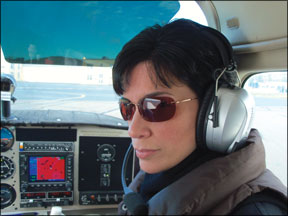
Some manufacturers claim to supply military fighter jocks, but Randolph is the real deal. In 1982, became the prime contractor for aviation flight glasses for the U.S. DoD and a lead vendor to various government agencies. Their consumer gear is still mil-spec.
We tested the RE Concorde model, an aviator design with grey, non-polarized lenses. The Concordes skull model temples fit we’ll and were easy to take on and off without removing the headsets. We especially liked the positive fit and grab-on feel of the silicone nose pads. Weve used Randolph models on the firearms range and they proved rugged enough for this harsh environment as they are for the cockpit.
Mile High
Our first reaction to the Mile High Chocks was to compare them to the rugged Oakley M-Frames. The Chocks, a close copy of the Oakley wraps, just felt too light. It turns out this is one of their strong points.
The other novel thing about the Mile Highs was the ability to easily swap out four sets of included lenses. Off into a dark grey sky? Snap in the yellow impact-conforming lenses. Bright sun? Install the smoked ones. There are three styles of frames to choose from. There are partially wrapping Soarers and the full-wrapping Chocks. There is also the squarish, flip-up style Aviates that let you to snap in prescription lenses behind the colored ones.
Outside the cockpit windows, we found the light-enhancing yellow lenses definitely brightened dark skies-in some conditions you would swear its sunny. But with eyes inside the cockpit, the yellow lenses are just too bright. The amber lenses, however, were a perfect match for partial sun and worked we’ll inside the cockpit. The smoked lenses? Not so good. We wished for more bright-sun shielding as well.
Interestingly, we found the MH Chocks our hands-down favorite for sports. The frames are light enough where you don’t know you are wearing them, the interchangeable lenses were extremely useful for playing under the changeable and often grey skies of New England, and they can take a beating. However, one of our test samples showed up with a scraped lens, so perhaps they arent as scratch-coated as claimed. Still, theyre the kind of glasses you can toss in your backpack, glove box or unorganized flight bag where theyll get beat up but can easily survive. For under $100, theyre a real value.
Vedalo, Ra Vision
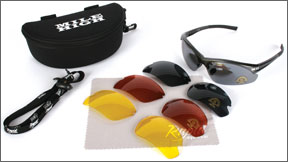
The Italian-produced VedaloHD Signature Series models surprised us with quality, performance and obvious metrosexual styling. Perhaps the most feminine-styled glasses in our group, we forked them over to our female tester and pointed the airplane eastbound into morning sun. Our typically outspoken and critical copilot gave the VedaloHD Azzuros high marks for comfort and performance commenting that she forgot they were on her head when clamped with headsets. They are also available with prescription lenses.
Vedalo is no sissy in sunglasses design. The lenses are impact, chemical and atmospheric-agent resistant, incorporate Vedalos NXT technology and are designed for the cockpit. The non-polarized HDL-3C lenses don’t use a tint or a coating. They have a filtering process impregnated directly into the lens the company claims results in increased color sensitivity and improved chromatic contrast. They are intended for reading LCD displays and instrumentation within a cloud deck without the need for backing them off your eyes. Speaking of backing, aerobatic legend Sean Tucker testifies that the Vedalos are the best hes used.
The rimless Ra Visions are designed to be adjusted to fit an individual face. The drill is to bend the frames for personal fit and comfort. Ra claims the glasses were designed to be worn with headsets and flight helmets, and we were able to bend them to our liking (mostly). When our heads were loaded down with headsets and a ball cap, the Ras were almost too flexible, bowing out when we wanted them to be flush with our skull. But they were extremely light-weight and durable. A tad punchy at the end of this review, we tried to snap the titanium frames in half but couldnt do it.
With choices of grey or brown non-polarized lenses, the Ra Vision optics are supposedly optimized for moving-fast, looking at flight instruments and gauges or through a windshield. Ra lenses are company-specific Trivex. We didnt have any complaints when using the grey lenses and the contoured design offered good side coverage. The styling was also a hit with the females in our test group.
Our Favorites
All of the sunglasses in our trial performed well. Frame style fit and comfort is another story, and we stress that buying from a local retailer or online from someone who will accept returns if they don’t fit we’ll is imperative. Our thanks to Sportys Pilot Shop for doing exactly that with several of the brands we tested. Vedalo offers a 30-day money-back guarantee. Ra Vision offers refund for one year.
Overall, we liked the Oakley M-Frame Hybrid wraps best in nearly every category we tested. Theyre rugged, sturdy and have high-quality smoked lenses that function flawlessly in nearly every lighting condition we looked at. If a full wrap design is too aggressive for your style, the Oakley Tight Ropes have lenses that are nearly identical performers but have traditional frames that sacrifice some long-term comfort.
Our testers were also impressed with the VedaloHDs. If enhancing and massaging LCD color avionics displays is high on your list, these lenses are worth trying. Were of two minds on the $250 price tag. We didnt feel they were exceptionally better than glasses that cost half as much, but if youve just spent $80,000 on a new glass panel, the difference in cost here is practically a rounding error. And they really do make the LCD displays shine.
For all-purpose models for both cockpit and sporting activities, Mile High wins hands down. In our view, they represent real value with four sets of interchangeable lenses that you’ll make use of. In fact, we found them so versatile, were actually keeping them.

